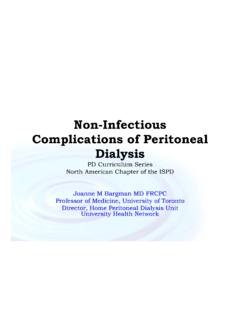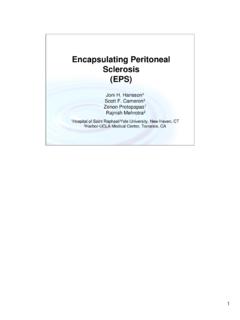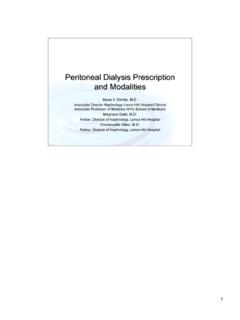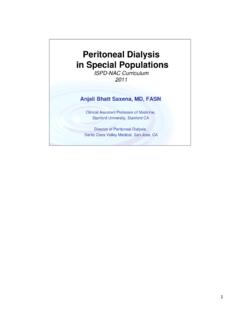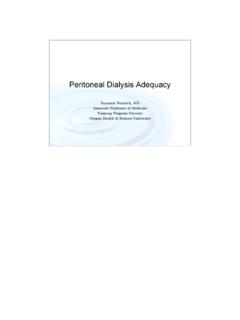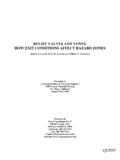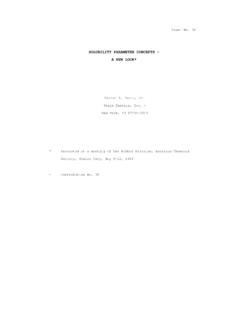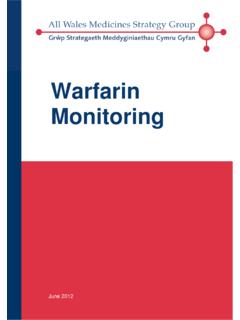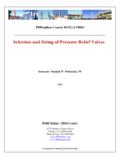Transcription of Peritoneal Dialysis Adequacy
1 Peritoneal Dialysis AdequacySuzanne Watnick, MDAssociate Professor of MedicineTraining Program DirectorOregon Health & Science UniversityOutline of Talk What is Adequacy (Definition)? What do the current guidelines say? What basic literature is important? How do we practically assess Adequacy ?Case to illustrate the Mr H is a 37 yo caucasian gentleman, ESRD x 4 years due to T1 DM since age 2 He chose PD because he still works full time Gastroparesis is his biggest complaint He stopped his midday exchange x 1 mo Insists he feels better: nausea, better appetite Regimen: 4 x nighttime exchanges of Dianeal; final fill and midday exchange of DianealCase continues The renal fellow gets all the appropriate information, and tells Mr H that he should not have stopped his daytime exchange.
2 Is the fellow correct? Is Mr H receiving adequate Dialysis ? What is Adequacy ? What is Adequacy ?Active learning exercise: How would you define Adequacy in terms of replacing renal function? In nephrology, Adequacy first used to describe an appropriate dose of hemodialysis (HD)* Adequacy for Peritoneal Dialysis adopted later Conceptual overall goal equivalent to HD, calculations not equivalent**Input objective measures of renal replacement therapy and daily livingAdequacy Algorithm S/ O/ A/ P/Input patient s subjective well-beingContinue what you are doingChange somethingAre goals being achievedNoYesWhat contributes to Adequacy ?
3 Broad senseControl of: Acid-base status BP and volume status Cardiovascular Risk Diet/nutrition Mineral/Bone disorders Small/middle moleculesPossibly most important: How the patient feels!What contributes to Adequacy ? Appropriate small molecular weight solute clearance Specifically measured as urea clearance In PD, you measure Kt/Vtotal= Renal Kt/V + Dialysate Kt/V Renal Dialysate Kt/V but this is how it is practically calculatedNarrow Sense: Adequacy : GuidelinesKDOQI GuidelinesMinimal delivered dose Total Kt/VureaAT LEAST per week. sum of Peritoneal and renal urea clearance Caveat: If urine output > 100cc/day, collection should be performed.
4 Adequacy : GuidelinesISPD Recommendations Adequacy should be interpreted clinically rather than via solute and fluid removal For small solute removal, total (renal + Peritoneal ) Kt/Vureanot less than at any time If pt relies on residual renal function to achieve Adequacy , monitor q1-2mo if able, but no less than q4-6 is Not FloorShow me the dataCANUSA Trial Led to prior guidelines of target for CAPD, higher targets for CCPD and NIPD, without data, but from theoretic considerations Prospective observational cohort, 680 pts Looked at relationship of Dialysis Adequacy and nutritional status to mortality, morbidity, and technique failure Decr of Kt/Vurearesulted in increased risk of death of 5%CANUSA continued Findings based on assumption that 1 unit of renal clearance = 1 unit of Dialysis clearance Reanalysis showed survival related to: residual renal function Declined over time Not Dialysis clearance Usually stable over timeShow me more data Prior Kt/Vureagoal (guidelines): Some patients looked clinically fine, but did not achieve goal Resulted in conversion of some to HD Would lower Kt/V achieve clinically adequate clearances?
5 2 important Randomized Control Trials: ADEMEX ( Adequacy of PD in Mexico) Hong Kong PD trial Both showed a lower achieved Kt/Vureadid not lead to higher mortality 1 965 patients randomized to: 4 daily 2L exchanges versus Increase in dose to achieve Peritoneal CrCl >60L/ Achieved CrCl 46 v 57 L/ Kt/V v No difference in overall survival 68 v 69%, at least 2 year follow-upADEMEX 2No differences by age, diabetic status, or serum albuminHong Kong Trial 1 320 incident PD patients Target total Kt/Vurea(PD + RRF) , , or > Good separation between groups Achieved appropriate total Kt/Vurea Peritoneal Kt/V: differences from month 1 No difference in renal Kt/V Survival no different between groupsHong Kong Trial 2 No difference among groups in: OVERALL MORTALITY Overall nutritional status Serum albumin Differences in: ESA dose Uremic symptoms higher ESA doses and more symptoms in Kt/V group onlyHong Kong 3 Effect of increasing Kt/V urea above on mortalityKt/V > = v Target Dialysis Dose Consensus: Kt/V = is a reasonable floor Dialysis dose, even though neither study showed a true minimum re.
6 Mortality benefit of Dialysis dose Recall, many natural phenomena follow a normal distribution - If is used as target Kt/Vurea, some will fall above and some will fall below. An important thought experiment for learners: what is a reasonable target so to achieve an adequate Kt/V of in almost all patients? Equations 1 Weekly Kt/V for PD Kt/Vurea not necessarily the optimal measurement, but what we use K = Volume cleared/time (Liters/day) t in days Vdurea ~ TBW (in Liters) Kt/V in PD over 1 day x 7 = Adequacy over 1 weekEquations 2 Calculate KureaRenal Clearance: Cx= [Ux] x urine Volume [Px]PD Clearance: Cx= [Dx] x dialysate Volume [Px] So, Kurea= D/Pureax dialysate VEquations 3 Weekly PD clearanceKt/V = [D/Purea x Dial Volume] x 7daysVdureaWhat is Mr H s dialysate clearance?
7 He weighs 70kg. He brings in his solutions. Samples show: dialysate urea = 36 mg/dlSerum urea = 42 mg/dl24 h dialysate Volume (see slide 3) = L*Vdurea (TBW) = 70kg x = 42 LThe unitless answer is for the weekEquations 4 Calculate renal Kt/VureaKt/V = [U/Pureax Urine Volume] x 7 daysVdureaWhat is Mr H s residual renal clearance?Urine urea = 437 mg/dlSerum urea (as before) = 42 mg/dlUrine Volume = 365 ml = LVdurea (as before) = 42 LitersRenal Kt/V = for the weekWhat is clinical Adequacy ?Now let s discuss Mr H s adequacyTotal Kt/V = Peritoneal + renal Kt/V = + = : He is achieving Adequacy 1) by numbers2) by subjective measures he SAYS he feels better3) by physical well-beingnot previously described, but his volume status, BP, lytes, minerals, & anemia are on targetAdequacy A state of well-being, not specifically defined by one number A minimum total Kt/Vureaof if you require a number Sum of renal function and dialysate Kt/Vurea RCT data exist!
8 (rare in nephrology) Determined by both patient & providerReferences Adequacy of Dialysis and nutrition in continuous Peritoneal Dialysis : association with clinical outcomes. Canada-USA (CANUSA) Peritoneal Dialysis Study Group. J Am Soc Nephrol 1996; 7:198. Bargman, JM, Thorpe, KE, Churchill, DN. Relative contribution of residual renal function and Peritoneal clearance to Adequacy of Dialysis : A reanalysis of the CANUSA study. J Am Soc Nephrol 2001; 12:2158. Paniagua, R, Amato, D, Vonesh, E, et al. Effects of increased Peritoneal clearances on mortality rates in Peritoneal Dialysis : ADEMEX, a prospective, randomized, controlled trial.
9 J Am Soc Nephrol 2002; 13:1307. Lo, WK, Ho, YW, Li, CS, et al. Effect of Kt/V on survival and clinical outcome in CAPD patients in a randomized prospective study. Kidney Int 2003; 64:649. Lo, WK, Lui, SL, Chan, TM, et al. Minimal and optimal peritonealKt/V targets: results of an anuric Peritoneal Dialysis patient's survival analysis. Kidney Int 2005; 67:2032. Jansen, MA, Termorshuizen, F, Korevaar, JC, et al. Predictors of survival in anuric Peritoneal Dialysis patients. Kidney Int 2005; 68:1199. Lam, MF, Tang, C, Wong, AK, et al. ASPD: A prospective study of Adequacy in Asian patients on long term, small volume, continuous ambulatory Peritoneal Dialysis .
10 Perit Dial Int 2006; 26:466. K/DOQI Clinical Practice Guidelines for Peritoneal Dialysis Adequacy . Am J Kidney Dis 2006; 47(Suppl 4):S1. European Best Practice Guidelines for Peritoneal Dialysis . Nephrol Dial Transplant 2005; 20(Suppl 9):1. Lo, WK, Bargman, JM, Burkart, J, et al. Guideline on targets for solute and fluid removal in adult patients on chronic Peritoneal Dialysis . Perit Dial Int 2006; 26:520. Brimble, KS, Walker, M, Margetts, PJ, et al. Meta-analysis: Peritoneal membrane transport, mortality, and technique failure in Peritoneal Dialysis . J Am Soc Nephrol 2006; 17 #1 A 52-year-old Caucasian gentleman on Peritoneal Dialysis for 2 years comes for his quarterly Adequacy measurements.
